Taiwan has historically been a beacon for economic growth and economic freedom in the Asia–Pacific. However, with China’s steady rise as an economic powerhouse, Beijing’s ability to influence not just the Taiwanese, but other countries’ relationships with Taiwan, has become increasingly worrisome and a drag on the market forces that should determine Taiwan’s place in the global economy.REF Taiwan is often left out as other countries sign new trade agreements. In addition to this long-developing problem, companies in Taiwan now risk being caught in the middle of an escalating trade dispute between Washington and Beijing.
The U.S. can no longer stand by, idly watching these dynamics play out. Nor can it allow Taiwan and American businesses in Taiwan to suffer unnecessary economic penalties aimed at China. Given the uncertainty of supply chains created by ongoing trade disputes, it is necessary for businesses and consumers to know that the U.S. has reliable trade and investment partners in Asia. Reinvesting in the economic relationship between the U.S. and Taiwan will defray some of China’s non-market-based influence.
To this end, the White House should establish a new high-level economic dialogue with Taipei that will push past trade conflicts and other political obstacles to a more meaningful partnership that will benefit both countries.REF
Outcast from the Trading World
In October 2018, the Australian government reportedly backed away from talks on a free trade agreement (FTA) with Taiwan, its 14th-largest trading partner, due to pressure from Beijing—Australia’s number 1 trading partner.REF To complicate matters, Australia has had an FTA with China since 2015.REF Despite growing skepticism of Chinese influence, Australia’s recent withdrawal from an FTA with Taiwan is a reminder of Beijing’s interest in managing other countries’ relationships with Taiwan.
Beijing’s influence reaches beyond government relations. Over the past few years, the Chinese government launched a campaign of sorts to force international private businesses, including some businesses with foreign-government affiliations, to change how they describe Taiwan. Airlines, such as Delta, Air Canada, and Air India; clothing lines like the Gap and Zara; and others companies, such as Audi and Marriot, were forced to change company documents and products to be more in-line with Beijing’s view of Taiwan.REF In some cases, they apologized for not already conforming to Beijing’s wishes.
Much like Chinese policies, Beijing’s efforts are slow moving. Taiwan is far from being completely isolated from the global economy. As a member of the World Trade Organization (WTO), Taiwan is able to take advantage of the “most favored nation” status and lower barriers to trade among members. Taiwan can also take part in the WTO’s dispute-settlement system, allowing Taiwan to challenge other countries’ illiberal trade practices. However, outside the WTO, as seen with Australia, countries that have diplomatic relations with China, except Singapore and New Zealand, have been reluctant to sign separate trade deals with Taiwan.
Another recent example is the Comprehensive and Progressive Agreement for Trans-Pacific Partnership (CPTPP), which will soon take effect. The trade agreement has already been ratified by six of its 11 signatories—Australia, Canada, Japan, Mexico, New Zealand, and Singapore. It will be one of the world’s largest trade agreements, accounting for roughly 13.5 percent of the world’s total economy.REF While some countries are still trying to persuade the U.S. to join since President Trump withdrew the U.S. from the trading block in 2017, Taiwan has had difficulties joining on its own.REF Taiwan very much wants to join the CPTPP.REF However, CPTPP members have been reluctant to support Taiwan’s ascension and risk angering Beijing.REF
Ironically, many of the CPTPP members see the deal as a good chance to counter markets where there has been government interference—such as in the industries in which China’s larger state-owned enterprises (SOEs) are heavily invested. However, a flaw of the CPTPP is its lack of a comprehensive effort to address SOE privatization and ensure fair competition between SOEs and private companies. Other analysts see the CPTPP as a chance to compete with the Regional Comprehensive Economic Partnership (RCEP)—a separate trade block that is commonly cited as being a Chinese-led trade deal (despite it actually being ASEAN-led), and is another deal that Taiwan has little chance of joining.
As other countries in the Asia–Pacific continue to sign new trade deals, these lower tariffs and reductions in non-tariff barriers give them a competitive edge over countries, including WTO members, that are not a part of the deal and continue to maintain higher barriers. Taiwanese manufacturers are worried about the losses they face from the new deals being made by regional competitors in South Korea and Japan.REF Free trade deals can also give confidence to cross-border investors. While these other countries economically unravel their dependence on China, Taiwan’s economy has increasingly become more dependent on China.REF
Taiwan’s Economic Dependence on China
Beijing is increasingly trying to win the heart—and wallets—of the Taiwanese. Over the past 15 years, Taiwan’s economy has increasingly become more dependent on trade with, and investment in, China. In 2003, China overtook the U.S. as Taiwan’s largest trading partner. Taiwan now trades twice as much a year with China than it does with the United States. Taiwan’s total trade with China was $139 billion in 2017. Trade with China now makes up almost 25 percent of all of Taiwan’s total trade.
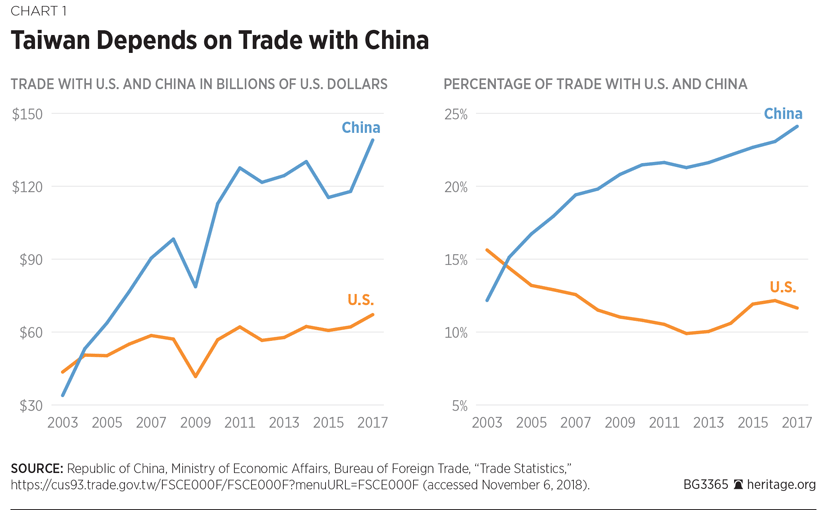
Taiwan, like many other developed market economies in the Asia–Pacific region, is desperate to find new areas of growth. For many countries, both developed and developing, that growth has increasingly been found in China. Taiwan invests as much in China as it does in all other countries combined. Chinese investment in Taiwan has significantly increased over the past decade as well, albeit from a low base. Chinese investment in Taiwan in 2017 was above $265 million, compared to just $37 million in 2009.
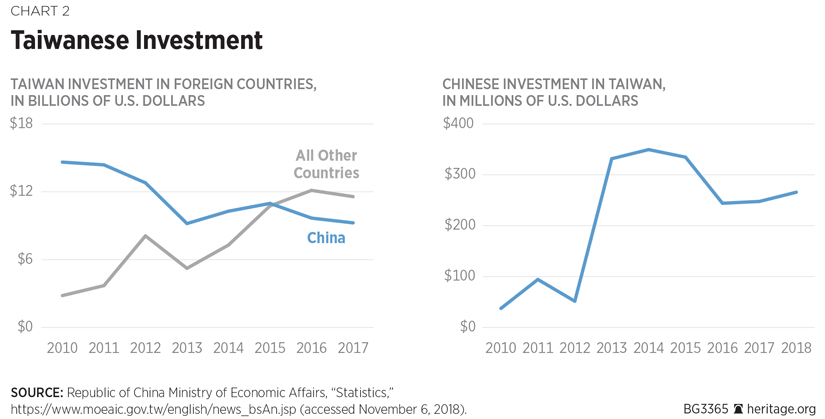
In 2010, Beijing and Taipei signed a trade deal to reduce tariff and non-tariff barriers, known as the Economic Cooperation Framework Agreement. However, Taipei questioned Beijing’s true intent, there were concerns about the deal’s sustainability and transparency, and later because of a breakdown in contact between the two sides, besides substantial “early harvest” provisions benefiting trade in goods and a few other details, the deal never went into full effect. A refusal by Taipei to sign oversight legislation left the deal only partly fulfilled.
In 2018, Beijing began a new approach. The Taiwan Affairs Office in China’s State Council initiated a program commonly referred to as “31 measures.”REF The program is billed as a way to increase economic and cultural exchanges between “compatriots” across the straits. On the surface, these measures range from encouraging economic cooperation as well as social cohesion. Measures include easing investment barriers and offering benefits for the families of those who wish to work in China. For example, Taiwan-funded enterprises are granted land use in the same way as mainland enterprises. Taiwanese citizens are also eligible for various cultural awards and honors.
But underneath the surface, it is clear that Beijing is offering economic incentives in order to extend Taiwan’s economic dependence, gain influence in Taipei, and secure new technology. Xiamen, a city in Fujian province and right off the shores of Taiwan’s Kinmen Island, quickly followed suit by introducing a similarly structured “60 measures” program.REF Other provinces, such as Shandong, have followed suit as well. Taiwan’s Executive Yuan—the executive branch of Taiwan’s government—wary of these efforts, responded with its own program to attract and retain Taiwanese domestic investment.REF
Given Taiwan’s place as a leader in advanced manufacturing, such as in its production of semiconductors, it is a prime target for Beijing’s “Made in China 2025” initiative as well.REF Beijing wants to become the world’s leader in advanced manufacturing. And it wants to lead the world in 10 unique sectors, including robotics, medical devices, transportation, and information technology. It is why one of the top initiatives of Beijing’s 31 measures is encouraging Taiwanese investment to help develop the Made in China 2025 policy.
U.S.–Taiwan Economic Relations
For the past 30 years, the U.S. and Taiwan have had a significant economic relationship through strong trade and investment. In 2017, the U.S. and Taiwan traded $87 billion worth of goods and services, making it America’s 12th-largest trading partner.
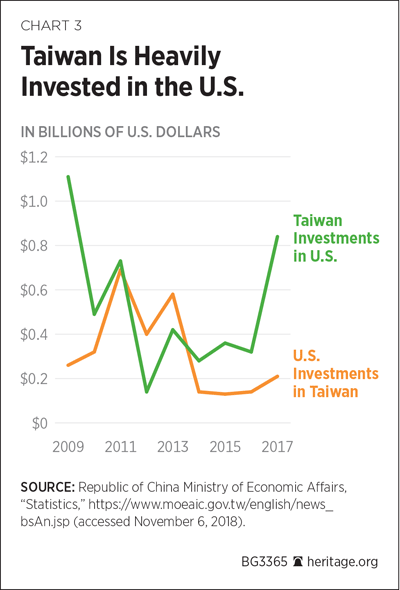
Cross-border investment between the U.S. and Taiwan was more than $1 billion in 2017. Companies like Amazon, IBM, Microsoft, and Yahoo have plans to invest in artificial intelligence development in Taiwan.REF But the levels of bilateral investment are not reciprocal. Taiwanese companies invest almost four times as much in the U.S. as American companies invest in Taiwan. Taiwanese investment in the U.S. was $837 million in 2017. This trend will likely continue to increase over the next few years given an announcement by Taiwanese company Foxconn to invest $10 billion in production facilities in Wisconsin.REF
The Taiwanese are investing in more than American production. Taiwan is the third-largest Asian investor in U.S. long-term securities. Taiwanese individuals have purchased over $576 billion in U.S. debt.REF Taiwan is also an increasingly significant licensor of U.S. intellectual property (IP). In 2016, U.S. companies made over $4.5 billion in IP revenue from Taiwan.
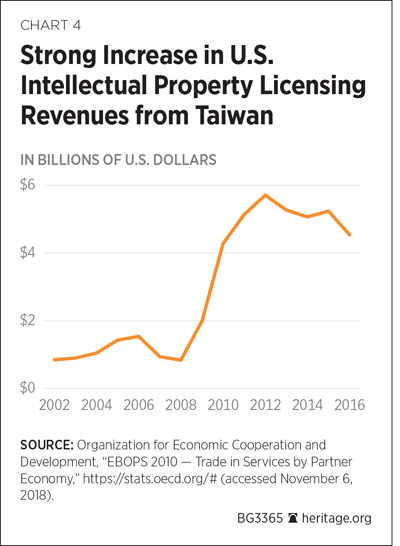
Taiwan’s total trade and investment supports more than 322,000 American jobs, according to the Taipei Economic and Cultural Representative Office in the U.S.REF Taiwanese investment supports 107,000 American jobs and more than 215,000 jobs from U.S. exports of goods and services to Taiwan. These numbers do not include the thousands of jobs that are created and supported in America by the imports of goods and services from Taiwan—adding value to U.S. manufacturing and supply chains. The value of trade with Taiwan adds more than $30 billion worth of benefit to the goods and services consumed by Americans.
There are still some barriers to trade and investment between the U.S. and Taiwan. While the U.S. has a Trade and Investment Framework Agreement (TIFA) with Taiwan to hash these issues out, the U.S. has not held TIFA talks with Taiwan since 2016.
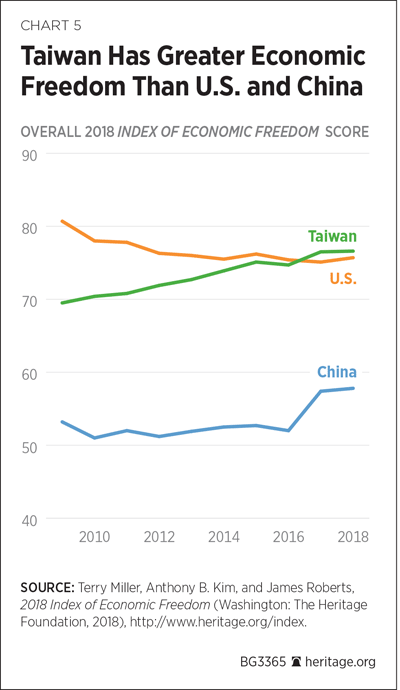
Yet since those last consultations in 2016, Taiwan has actually become more economically free than the U.S. The U.S. has a total economic freedom score of 75.7 out of 100, as measured by The Heritage Foundation’s Index of Economic Freedom. Over the past decade, the economic freedom of Taiwan has been increasing while the economic freedom in the U.S. has been decreasing. Today Taiwan has an overall score of 76.6 out of 100—placing it in the category of “mostly free.”REF Taiwan has strong property rights, limited government spending, and good business freedom. But it also has weak labor freedom, judicial effectiveness, and financial freedom.
Taiwan’s individual scores for trade and investment freedoms are below those of the U.S. but are still relatively high. Already Taiwan’s average tariff rate of 6 percent is low compared to international standards.REF Non-agricultural tariffs average about 4 percent while agricultural tariffs average about 16 percent.
The number of new tariffs the Trump Administration has put in place since 2017 constitute an assault on Americans’ freedom to trade. And Taiwan has found itself caught in the middle of a number of trade disputes that have arisen. Since the beginning of 2017, companies in Taiwan have been at risk of being subject to direct costs through the increase of tariffs on solar panels and steel. There are potential indirect costs, too, as companies respond to tariffs on Chinese imports to the U.S. Taiwan relies on a diverse global trading system, often benefiting from both U.S. innovation and Chinese manufacturing.
Despite having to deal with the new cost of tariffs, Taiwan has a history of making procurement trips to the U.S. under self-initiated “buy American” trips, particularly for agricultural products. Just last year, a delegation signed deals to export up to $3 billion worth of U.S. corn, soybean, wheat, and other grain.REF Taiwan plans to increase its purchases of soybeans by a third until the end of 2019.REF While government-led procurement trips tend to have market-distorting effects, this meaningful gesture helps American soybean farmers, who have also been caught in the middle of a trade dispute between the White House and Beijing. American soybean farmers have lost both profit and market share in China, and Taiwanese investors have stepped up to support them.
Establishing a U.S.–Taiwan Economic Dialogue
Currently, the U.S. has an economic working group, a high-level economic dialogue, a free trade agreement, or intentions to enter into trade negotiations with any number of its economic partners in the Indo–Pacific, including Australia, Singapore, South Korea, and Japan. Since 1995, the TIFA has traditionally been a meeting of senior U.S. and Taiwanese government officials to discuss outstanding bilateral trade issues. The talks have recently been held at the Deputy Secretary level under the auspices of the American Institute in Taiwan—the unofficial instrument of America’s relationship with Taiwan.REF
However, the U.S.–Taiwan TIFA talks have a history of being postponed over specific trade disputes. When the U.S. and Taiwan do meet next, the meeting would lack the authority to pursue larger, more comprehensive initiatives. This is why the White House needs to re-engage with Taiwan by establishing a new high-level economic dialogue much like the one between the U.S. and Japan that is capable of overriding political obstacles.
A Framework. In early 2017, President Donald Trump and Japanese Prime Minister Shinzo Abe agreed to launch a new high-level economic dialogue.REF That year, the two sides reaffirmed the importance of deepening trade and investment opportunities, and pledged to explore ways to promote trade, economic growth, and higher industrial standards in the Asia–Pacific.
Much like the dialogue with Japan, a U.S.–Taiwan economic dialogue would pursue mutually beneficial opportunities for economic growth and job creation. It would seek to abolish existing tariffs and non-tariff barriers. It would also seek new areas in which U.S. and Taiwanese businesses have greater opportunities for investment.
Taiwan shares many of the same priorities as the U.S. and Japan, and is therefore an important relationship to grow. The U.S.–Taiwan economic dialogue can easily be built with a framework similar to the U.S.–Japan dialogue.REF This includes focusing on three areas of interest: (1) a strategy for building trade and investment rules and addressing disputes; (2) cooperation on economic and structural policies; and (3) sectoral cooperation.
There are still plenty of issues that need to be worked out between the U.S. and Taiwan. The Office of the U.S. Trade Representative highlights its concerns over Taiwan’s handling of agricultural and farm imports in its regular report on foreign trade barriers.REF This includes addressing limits on the imports of American beef and pork. There are also issues regarding trade and labeling requirements. Other concerns include barriers to financial services and investments in agricultural production, chemical manufacturing, and health care. American businesses in Taiwan have also highlighted concerns over energy availability, labor requirements, and regulatory practices. Many of the issues simply highlight not just inconsistency with U.S. or international standards but a lack of transparency and steady implementation of regulatory requirements.REF
Areas for Cooperation. The U.S.–Taiwan economic dialogue would be wasted if it did not identify areas for cooperation. The dialogue should be a way to show investors and countries alike that the U.S. supports economic engagement with Taiwan. In addition, the two countries should be willing to collaborate in areas of development across Southeast Asia, which would be in line with Taiwan’s New Southbound Policy to expand cooperation in South and Southeast Asia. This includes working together to counter other countries’ unfair influence, market distortions, and illicit activities.
One area of cooperation is in the fostering of innovation for the digital economy. This is something that was supported by the American Institute in Taiwan and the National Development Council. Every day more people across Asia connect via the Internet, using cell phones for communication and financial purchases. Soon, it will be more than just people that are connected and communicating as countries in Asia look to build greater networked systems. The U.S.–Taiwan economic dialogue can build on the work that is already a part of the Digital Economy Forum—a bilateral exchange between the U.S. and Taiwan on ways to promote electronic commerce.REF This cooperation can help set standards and norms across Southeast Asia.
A number of countries in Asia still have restrictions on where, and how much, private companies may invest. According to the USTR trade barriers report, both the U.S. and Taiwan agreed to explore the possibility of re-establishing the Investment Working Group under the TIFA. The U.S. should work toward increasing investment opportunities, such as in electronic commerce. However, there are increasing regulations in Asia that force foreign companies to invest more in building local computing facilities or require the transfer of source code. While there should be greater cooperation with Taiwan in order to counter other countries’ unfair trading practices, including theft or unauthorized duplication of technology, the U.S. also needs allies that can help push against this new wave of digital protectionism.
A third area for cooperation is energy. Given both the demand for energy in Taiwan, and increased production in the U.S., there has been a significant increase in Taiwan’s purchases of crude oil and petroleum products over the past few years. Taiwan’s state-owned oil and gas company, CPC Corporation, signed a memorandum of understanding to purchase liquefied natural gas from the U.S. for the next 20 years. Again, while a purchase made by a government entity distorts markets, it shows the importance of U.S.–Taiwan trade. The U.S. should seek to expand opportunities to export energy for Taiwan’s private consumption.
Addressing new areas for cooperation should not necessarily take priority over resolving outstanding issues in the economic dialogue. According to public comments collected by the U.S. International Trade Commission in the late 1980s, “whether or not there is an FTA, the United States and Taiwan need a comprehensive trade framework that would contain ‘principles, targets, and dates’ for resolving trade issues.”REF A high-level economic dialogue should serve as laying the groundwork for an FTA as well—just like the U.S. and Japan announced their upcoming trade deal after a number of economic dialogue meetings.
Beijing will object to any new initiative between the U.S. and Taiwan, whether it is economic or political in nature. But an economic dialogue, even high-level, would fall well within the boundaries of the U.S.’s traditional one-China policy, consisting of the three U.S.–China communiqués, the Taiwan Relations Act, and Reagan’s Six Assurances. And such a dialogue would be a significant precursor to a U.S.–Taiwan FTA. The Taiwan Relations Act states that it is a policy of the U.S. “to preserve and promote extensive, close, and friendly commercial, cultural, and other relations between the people of the United States and the people on Taiwan.”REF As members of the WTO, both the U.S. and Taiwan are allowed to negotiate a free trade agreement.
Steps for the U.S.
The U.S. should pursue every opportunity to promote free-market principles in the Asia–Pacific. The U.S. cannot reasonably go it alone if it wants to significantly address other countries’ non-market activities. The U.S.–Taiwan economic relationship is one worth investing in to promote U.S. interests in the region. Therefore, it is important that the White house:
- Establish a high-level economic dialogue between the U.S. and Taiwan. The dialogue should be comprehensive, including not just trade issues but non-tariff and 21st-century areas for cooperation.
- Instruct that the U.S.–Taiwan economic dialogue be led by the U.S. Trade Representative and Secretary of Commerce, who will likely be met by counterparts on the Taiwan side who are responsible for these issues.
- Instruct the Deputy USTR Secretary to meet Taiwan’s Deputy Minister of Economic Affairs for the 11th round of the TIFA, in order to move forward this new dialogue.
- Commit the economic dialogue to meet at least once every six months. And, two years after launching the economic dialogue, announce plans to begin negotiations for a U.S.–Taiwan FTA under the guidance of the Trade Promotion Authority.
- Commit, during FTA negotiations, to remove tariffs on steel exports from Taiwan.
Conclusion
Low-level U.S.–Taiwan economic talks are often postponed because of unnecessary politics. The U.S. wants the removal of barriers to the import of beef. But Taiwan does not want to offer something for nothing. It is time for both sides to move past ultimatums and single issues. The new dialogue should be established without any preconditions other than a full commitment to liberalize trade and investment.
Congress has been supportive of the U.S.–Taiwan relationship, and officials in Taiwan are hopeful for a new round of TIFA talks since the USTR Deputy Secretary position has been filled. Both the governments in Washington and Taipei should strive to build confidence for U.S. and Taiwanese businesses, reduce uncertainty, and provide greater opportunities for trade and investment.
—Riley Walters is Policy Analyst in the Asian Studies Center, of the Kathryn and Shelby Cullom Davis Institute for National Security and Foreign Policy, at The Heritage Foundation.


